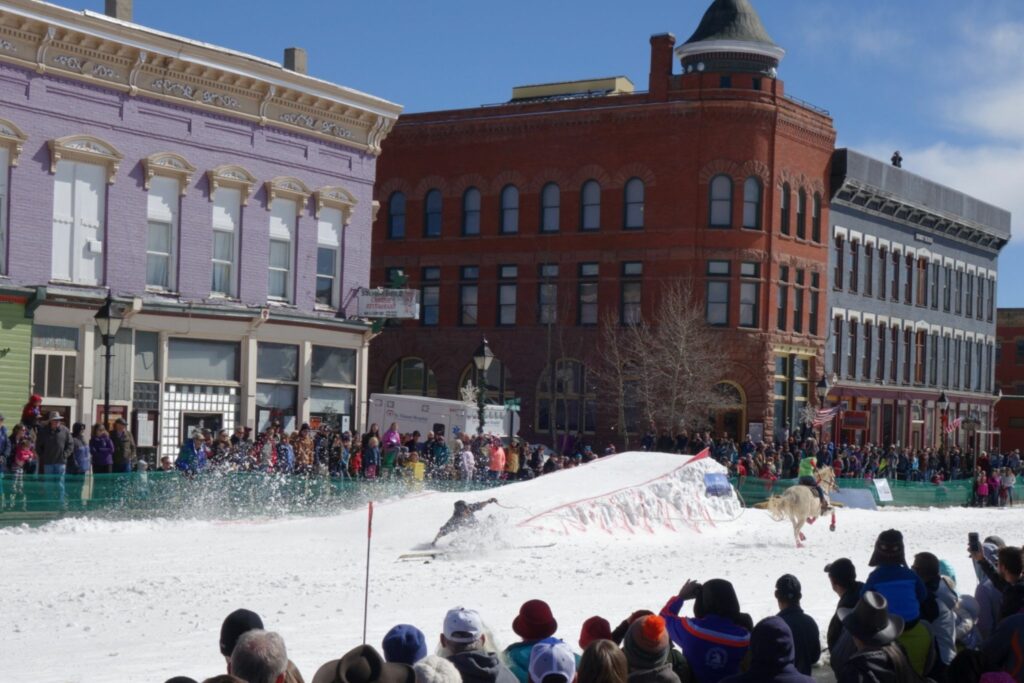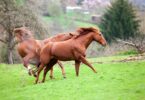Feeling the need for speed? Grab a few essentials and try the sport of horse skijoring!
In the dead of winter, with sub-zero temperatures nipping at your nose, it can be a challenge to find ways to keep yourself and your horse entertained. The days are short. Darkness comes far too soon. Is there anything that can cheer you up?
Thanks to Scandinavian ingenuity, the sport of skijoring offers an exciting way to get out on those blustery winter days and have some good ‘ol fashioned fun with your horse.
Whether you’re brand new to skijoring or want to take your runs to the next level, you’ll need the right equipment. That’s what this article is all about.
What is Horse Skijoring?
Skijoring (pronounced “skee-joor-ing”) translates to “ski driving” in Scandinavian.
Though the sport can take several forms, it typically involves a skier being pulled by either a horse or team of dogs. (Of course, as equestrians, we’re going to focus on the horse skijoring world.)

Source: Bottomless Backpacks
A skier is pulled behind a horse that is either being ridden by a second person or steered by the skier herself. Skiing while steering a horse is a more complicated and requires horse and rider to be familiar with pull-reining.
For the beginner, we definitely recommend skijoring with a mounted partner.
Check out this video to see skijoring in action:
If you’re bored with traditional skiing and want a way to keep your horse active in the winter time, this is the sport for you. Not only is it a new and exciting way to spend time with your equine and human friends, it’s also a great workout.
Hello, buns of steel!
Essential Horse Skijoring Equipment
For the Skier
- Helmet: Safety first, people. It’s not wise to strap yourself into skis behind an animal that can run at double-digit speeds without a helmet. (Click here to browse top-rated ski helmets on Amazon.)
- Skis: You’ll want the down-hill kind, not cross country skis, as down-hill skis offer greater stability at high speeds. If you’re not a regular skier, don’t worry. You can pick up a solid pair on Amazon (see our top picks for men and women) or check your local resale sports store for used skis.
- Ski boots: Your boots will snap into your skis, which means you’ll be nice and locked in for your ride. (Atomic sells a budget-friendly men’s option on Amazon, and Rossignol has a high-end women’s boot on Amazon if you plan to ski frequently.)
- Snow pants: We recommend the bibbed kind, that way you don’t get snow down your pants, if (or rather when) you wipe out. Arctix mades budget-friendly, customer-loved options for men and women that are available on Amazon.
Gloves: Protect your hands from the rope — and the cold. (We love the battery heated gloves from Sun Will, and they are a saving grace in Montana’s frigid winters.)
- Goggles: To protect from cold air and flying ice and snow, strap on some goggles. (They also protect you from flying horse poo!)
- Heavy coat: It is winter, after all!

Source: Bottomless Backpacks
For the Rider
Helmet: You read it above, but it’s important enough to mention twice. Check out our favorite riding helmets and winter balaclavas on the Horse Rookie Amazon Essentials List.
- Warm clothing: You may not be at as high of a risk of wiping out into a pile of wet, freezing snow as the skier, but you’ll still want to be warm and toasty while you ride.
Gloves: As we mentioned above, we love the battery heated gloves from Sun Will. Don’t be surprised if you start wearing them for all winter riding.
For the Horse
- Western saddle and breast collar: Most horse skijorers use a western saddle with a breast collar to distribute the weight/pull of the rope.
- Sturdy rope and carabiner: This article from skijoringamerica.com shows how to attach your rope to pull the skier behind your horse.
-
Saddle pad: Any one of the pads on our Best Trail Riding Saddles Pads list will do the trick.
- Studded ice shoes, bell boots, and/or other protective leg/hoof wear: These may not be necessary for beginners taking it easy, but if you’re serious about the sport it’s worth considering these options. (Pro Tip: We love the SMB Combo Boots from Professional’s Choice for support and overreach protection!)
Skijoring Tips for Beginners
- Wear a helmet, whether you’re riding the horse or skiing behind it!
- Double-check all tack and equipment before you begin, especially your ski rigging. Pay special attention to any knots.
- Make sure your horse is comfortable and desensitized to pulling a rope/rider behind him.
- Get comfortable on skis first so you don’t wipe out as often. (Fewer wipe-outs = fewer injuries.)
- Be aware of your horse and partner at all times.
- Only go as fast as you, your partner, and your horse are comfortable going.
- Watch and learn! Attend a few events in person and watch a lot of YouTube videos so you understand the basics before you try it yourself. Want some inspiration? Check out the World Championship video below:
Rules and Regulations
For casual skijoring, there really aren’t any rules. If you’re interested in entering a competition, however, most organizations publish a set of official rules on their websites.
Be sure to see if any additional equipment is required–or disqualifying–before you arrive.

Source: Bottomless Backpacks
The Next Big Thing in Winter Sports
For most equestrians, winter is a frustrating time. There’s too much snow, or it’s too cold outside to enjoy spending much time on horseback. Skijoring is the perfect way to get out during the colder months and actually enjoy all that snow.
So, grab a friend, saddle up your trusty steed, and get out there!

Source: Bottomless Backpacks
P.S. Enjoy this article? Trot on over to:
- 8 Best Horse Cameras (Action, Helmet, Trailer, Barn, Drone)
- What to Wear Horseback Riding
- Equine Odometers: How Far Can Horses Travel in a Day?
- You CAN Do This: Trailering a Horse for the First Time
- How to Ride a Horse for Beginners
- Ranch Roundup: 10 Best Horseback Riding Vacations in Montana
- 5 Weird Reining Stop Tips That Actually Work








